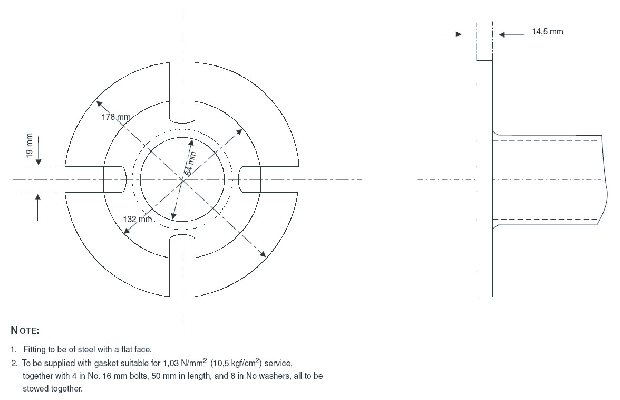1.2.1 The arrangements
of the structural fire protection, the fire detection and alarm systems
and the means of extinguishing fires are to be examined as far as
is practicable.
1.2.2 The Surveyor
is to check that no significant changes have been made to the arrangement
of the structural fire protection and fire equipment where fitted
on the ship since the approval of the original plans. If changes have
been made, the Surveyor is to advise the LR Naval liaison office of
these and request the Owner/Naval Authority to ‘update’
the arrangement plans and forward a copy to the Plan Approval office
with details of all new installations used.
1.2.3 The Surveyor
is to check that the fire/smoke/heat detectors are working efficiently
by initiating a test on the system and that all fire-alarms are audible
throughout the ship. The Surveyor is also to check that there are
a sufficient number of spare heads for each type of detector used
on board the ship and that they are readily accessible.
1.2.4 All sections
of the fire main are to be pressurized and tested for leaks and all
fire hydrants are to be examined and tested.
1.2.5 All fire hoses,
nozzles and fittings are to be checked and all hoses examined to show
that there are no signs of rotting in the hose material. The Surveyor
is to check that all hoses are stowed with their relevant fittings
in their correct positions. Hoses may be required, at the discretion
of the Surveyor, to be tested to their normal working pressure.
1.2.6 Two fire pumps
are to be tested separately. The capacities are to be verified and
the outlets checked to demonstrate that two jets of water can be discharged
simultaneously from two different hydrants, one forward and the other
aft. At the same time, two hoses should be tested to the working pressure
to show that they are not leaking.
1.2.7 All fixed
means of fire-extinguishing (i.e. CO2, Halon, etc.) are to be checked
and where possible to be blown through with clean, dry, high pressure
air to ensure that all nozzles are clear and associated pipework is
clean and clear. All alarms which sound as a warning, when the extinguishing
agent is to be released, should be checked and functionally tested
and also checked that the warning is relayed to the relevant control
room. All storage bottles should be weighed to check for possible
loss of contents. All remote controls for the release of the agent
are to be checked and tested. The date of pressure testing of pressurised
cylinders is to be checked against national or Naval Authority requirements,
generally this should occur every 20 years.
1.2.8 The Fire Control
Plan should be checked to ensure that no alterations have been made
to the positions of firefighting appliances/equipment since the plan
was placed on board and that the required number of plans and their
positions are correct.
1.2.9 The Surveyor
is to check that all portable and semiportable fire-extinguishers
are in their correct positions and that they have been properly maintained
and serviced by an approved servicing agent/person. Random checks
for evidence of discharged containers should also be made. The Surveyor
is to check that there are adequate spare charges for each type of
extinguisher used on board and that they are easily accessible.
1.2.10 The Surveyor
is to verify as far as is practicable that the remote control stops
for ventilation fans serving machinery spaces and accommodation spaces
are in good working order, easily accessible from outside the spaces
being served and at the same time to check that the means of stopping
the ventilation fans serving the galley are operable and within the
galley. It should be noted that the ventilation fans, etc. serving
the machinery spaces should be completely separate from all other
ventilation systems.
1.2.11 The Surveyor
is to check that all fireman’s outfits are in good condition,
that all breathing apparatus is in working order and that the necessary
spare, fully charged, bottles are readily available.
1.2.12 All escape
breathing apparatus are to be in place and functional.
1.2.13 The Surveyor
is to check as far as possible that all escape routes are free of
obstruction.
1.2.14 The Surveyor
is to check that copies of all records of servicing of fire-fighting
equipment are held on board the ship for easy reference.
1.2.15 The Surveyor
is to check that all fire flaps, where fitted in ventilation trunking,
whether remotely controlled or manually operated, are working efficiently
and that the open/closed positions are adequately marked.
1.2.16 The Surveyor
is to check that the International Shore Connection (see Fig. Figure 19.1.1 International shore connection) is in good order and stowed in
an easily accessible position with all necessary fittings.

Figure 19.1.1 International shore connection